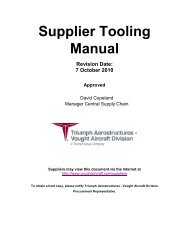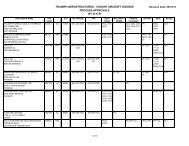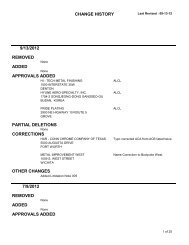SIP Summary Plan Description - Vought Aircraft Division
SIP Summary Plan Description - Vought Aircraft Division
SIP Summary Plan Description - Vought Aircraft Division
You also want an ePaper? Increase the reach of your titles
YUMPU automatically turns print PDFs into web optimized ePapers that Google loves.
Retirement Contribution Account<br />
Effective January 1, 2006, a Company-funded Retirement Contribution Account (RCA) was<br />
established for certain eligible participants. Additional participants have become eligible for the<br />
RCA in subsequent years. The matrix on page 2 identifies which participants are eligible for<br />
Retirement Contributions.<br />
Amount of RCA Contributions<br />
If you are eligible to receive Company Retirement Contributions, the Company will contribute to<br />
your RCA an amount equal to 3% of your eligible earnings each week. Beginning on January 1,<br />
2008, the Company began contributing the greater of 3% of eligible earnings or $45 each week<br />
for employees eligible to receive Company Retirement Contributions. In order to receive<br />
Company Retirement Contributions in a given week, you must have eligible earnings for that<br />
week.<br />
These contributions to your RCA and their investment earnings are tax-deferred until<br />
withdrawal. You do not have to make pretax or after-tax contributions to receive Retirement<br />
Contributions. Company Retirement Contributions are credited to your account according to<br />
your investment elections for your Company Matching Contributions. If you have not made an<br />
investment election for your Company Matching Contributions, the funds will be invested in the<br />
<strong>Plan</strong>’s qualified default investment alternative, which is the Target Date Retirement Fund that<br />
has a target date closest to your 65 th birthday.<br />
Vesting<br />
Vesting Service<br />
Vesting means you have full ownership of all the funds in your account, and you may take vested<br />
funds with you if you leave the Company. You are always 100% vested in your own<br />
contributions and any corresponding investment earnings. You may be required to perform a<br />
certain amount of service for the Company (Vesting Service) in order to become vested in<br />
certain employer-provided contributions (including Company Matching Contributions and<br />
Company Retirement Contributions) and their corresponding investment earnings. If you<br />
terminate employment before vesting in the employer-provided contributions, they, along with<br />
any corresponding earnings, will be forfeited. Vesting Service under the <strong>Plan</strong> is generally<br />
determined by the period of time from your original hire date until your termination date. If you<br />
have a break in service that is greater than five years in length, you will forfeit any unvested<br />
employer-provided contributions received before the break, and your service before the break<br />
will not be used to determine your Vesting Service in employer-provided contributions received<br />
after the break.<br />
8








